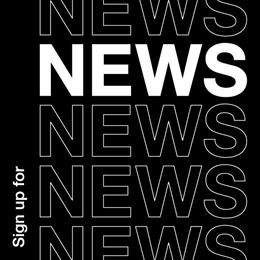The Verdict: Milan Symphony Orchestra

The work
The renowned Orchestra Sinfonica di Milano (Milan Symphony Orchestra) partnered with global brand consultancy Landor to refresh its identity. Aiming to become more accessible to a wider, international audience, the rebrand takes inspiration from Milan's music and culture. Landor utilised these design elements to convey emotion, while also tapping into the contemporary, with the rebrand resulting in a 56% increase in subscription sales since launch.
The new design system was heavily inspired by Futurism, an avant-garde Italian art movement hailing from Milan in the early 20th century. The aesthetic was used create a reactive interaction with music. For instance, the M glyph suggests a sound wave that represents Duomo of Milan, the city’s iconic cathedral.
Through coordinated images and a new custom typography, named TUMB TUMB, the logo was designed to move like a sound wave.
Teemu Suviala, global chief creative officer at Landor, comments, “Orchestra Sinfonica di Milano has a deep, emotional connection to Milan, so it was hugely important for us to incorporate the city into the rebrand. We took inspiration from the design, architecture, artworks and art movements cultivated in the city to create an identity that reflects it.
"The avant-garde Milanese artform Futurism was particularly influential alongside the phenomenon of synaesthesia, with sounds enabling multi-sensorial experiences, and the potential for reactive interaction with music.”


Peer review
Christophe Rolland, founder and strategy director, Branding Age
Have you ever been captivated by something in a store window, only to be disappointed when it's nowhere to be found inside? This reflects the experience with the Orchestra Sinfonica di Milano's rebranding.
The reveal video showcases a dynamic logo, a popular trend. However, the use of motion vibrates in ways that symbolise the orchestra's diverse offerings from jazz to tango, making it strategically relevant. The diversity of sounds — vibration, percussion, crescendo, decrescendo — literally animates the logo. This should be the essence of the strategy.
Yet, this vibrancy vanishes outside the reveal. On the brand's communication materials, especially on its website, the logo is static, disappear, and the iconography is rather generic.
This rebranding is a missed opportunity, where strategic potential becomes merely ornamental, with a somewhat forced invocation of futurism. Should we blame the agency? The gap between the exciting reveal and the timid application rather highlights an industry flaw, what one might call the 'beauty contest syndrome'.
Nevertheless, it’s never too late to embrace the strategic activation initially promised. Everything needed is already at hand.

Paul Cardwell, co-founder, Saboteur
Ah, an orchestra using kinetic type. Obviously, it's not the first time we've seen that, but if there's one area where movement is totally relevant to the brand story then it's clearly music. This is a very polished example of it being done well. The logo, with its echo of the Duomo, is elegantly rendered and beautifully applied, so manages to turn something which could have been corny into something accessible yet sophisticated.
Not an easy thing to pull off, but done with real flair and panache.
I have only one carp, and it's a geeky design thing. The typography is described as a nod to Marinetti and Futurism. Hmm. Brave choice. Marinetti despised verbs or adjectives. He just threw nouns onto the page. They were in circles, diagonals, explosions. Anything but horizontal or vertical. The type was meant to dramatise the meaning. He wanted to rid the world of the "smelly gangrene of professors and archaeologists". So this is Futurist Lite. Or, perhaps, Polite.
The Orchestra Sinfonica di Milano is a great asset for a wonderful city. And now they have the identity they deserve. Bravo.

Carl Johan Larsson, executive creative director and partner, Everland
We’ve seen many great institutional redesigns lately. I particularly love the redesign of the Sydney Opera House made by Interbrand a couple of years ago. Landors' approach is totally different, digging into the culture and Futurism, an avant-garde Italian art movement. This makes the brand timeless and beautiful. The TUMB TUMB typeface with the delicate details brings personality and reflects the heritage. It’s a great springboard to the motion bringing the identity to life – visualising music in a dynamic and extraordinary way. You can almost hear the music from the font alone. Nicely done.
The craft is the strongest element in this identity, it's so damn beautiful. And the connection to the feeling of the music is really strong, giving the identity a distinct look with the negative space as a twist in the overlapping glyphs. Yet, I still think they could have pushed it even further. It’s so close to being really new for the category. But overall: WOW!

Jennie Potts, creative director, B&B studio
There’s so much to like about this identity. Landor has managed simultaneously to celebrate a cultural institution and a city. The new design system delivers a dynamism and modern energy that feels exciting and contemporary, whilst also reinforcing the status of this important orchestra, paying due respect to its roots.
By bringing together multiple cultural influences, from futurism to the Duomo, and of course the sound wave itself, the identity creates a sense of both cutting edge innovation and respect for legacy.
The logo mark has a status and memorability, but the identity system also works in its different elements, for example when combined with photography, copy or as a graphic pattern. Importantly, it feels very digital first and is reflective of the need for identities to live fluidly in the digital world. Its connection to sounds means it could move further into the world of sonic branding.
It feels a truly dynamic and variable design system that can be tuned up or down depending on the touchpoint – just like music itself.

This article was taken from Transform magazine Q3, 2024. You can subscribe to the print edition here.













